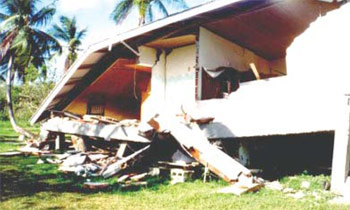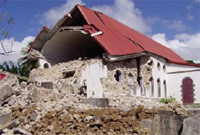|
April - May 2008

Issue Home >>
|
 Shake,
Rattle & Roll Shake,
Rattle & Roll
What has history taught us about earthquakes?
“Many were killed. I lost five family members in the quake. But we have
no time to weep. We have to work for the living right now.” Dawuti Aximu,
a young Uighur man, told the Associated Press news agency in 2004, after
an earthquake shook his village in the Chinese province of Xinjiang.
Almost 10,000 homes and 900 classrooms at 30 schools were levelled by
the quake. At least 260 people died and more than 4,000 were injured.
The quake had a severe effect on the local economy, which is heavily
dependent on farming. One man who sells traditional rice and roasted
mutton in the town said he had re-opened “because we all have nothing to
eat. Everyone has to eat”.
“My house is gone. Three relatives are gone. But life goes on.”
Very few communities in the world have not been touched by natural
disasters. In the Caribbean we’ve seen our share of tragedy. One
catastrophic event that will forever be highlighted in our history books
- the eruptions of Mt. Pelée in Martinique and St. Vincent’s Soufrière
in 1902, where over 30,000 people died.
Today we have that fascinating, ominous fire breather in Montserrat,
which has been erupting since 1995. The eruption of the Soufrière Hills
volcano has made two-thirds of the island unsafe for human occupation,
causing a mass migration of almost half of the population. The danger
from an active volcano should not be taken lightly: ash can affect the
operation of jet engines, and cause them to stall while breathing
ash-laden air aggravates respiratory conditions, and prolonged exposure
can cause damage to healthy lungs. Nature’s ingenious system of land
reformation can be both beautiful and dangerous.
The Seismic Research Unit at The University of the West Indies has been
actively monitoring earthquakes, volcanoes and tsunamis in the Eastern
Caribbean and sharing this information with the general public since it
was established in 1952. Experts have explained that , “In the global
setting, the Caribbean is a relatively small plate. However, the
processes involved in plate motion make the islands and countries lying
on the plate boundary vulnerable to geological hazards sufficiently
serious that they should be catered for in all long-term development
plans.”
The earthquake and volcanic activity in the Eastern Caribbean result
from the movement and sinking of the North American and South American
Plates beneath the Caribbean Plate, a process described as subduction.
On average, the Eastern Caribbean generates an earthquake of magnitude
greater than 7.0 approximately every 20 years and one of magnitude 8.0
and above every one hundred years. The most recent strong earthquake was
on 29th November, 2007 and occurred east of Martinique. However, there
was no great earthquake, magnitude 8.0 and above, in the Eastern
Caribbean during the 20th Century.
Throughout the region stakeholders including governments and architects,
are becoming more aware of the need for urban planning with insight into
natural disasters. History has taught us many lessons. Experts from the
Seismic Research Unit explained that in the 19th Century when the
colonial powers settled the islands of the Caribbean, and constructed
buildings of stone, they did so ignorant of the earthquake hazard.
Unfortunately the effects were disastrous- the great earthquake of 8th
February 1843, east of the Lesser Antilles, between Guadeloupe and
Antigua, was felt as far south as British Guiana. The high damage area
had a radius of about 250 km, and extended from Saint Lucia to St.
Martin. Close to the epicentral area, the city of Pointe-à-Pitre, in
Guadeloupe, was destroyed and over 4,000 people lost their lives.
The Seismic Research Unit’s experts have explained that in the closing
decades of the 20th Century, so-called natural disasters appear to have
been on the increase. Research suggests that human activity has
contributed in large measure to the phenomena of global warming with its
associated consequences, the hole in the ozone layer, forest fires,
flooding, to list just a few. Although the geological hazards do not
appear to be susceptible to human activity in the same way, how and
where we choose to live can and do affect the scale of the effects from
earthquakes and their associated hazards. For example, for the death
toll of 200,000, to be as high as it was for the 2004 Sumatran
earthquake, and the associated tsunami, that number of people had to be
in the affected areas at the time, absence of warning not withstanding.
The SRU also suggests that “Choosing to introduce high-density
population centres in coastal areas, going so far as to reclaim land to
do so, in a region known to have significant seismic act ivity is
imprudent, to say the least”.
A strong earthquake, magnitude 6.1 and over, occurs somewhere in the
world, on average, every two to three days, and a great earthquake,
magnitude 8 and above, approximately every year. But an earthquake does
not have to be one of the biggest to produce catastrophic results. And
so constant monitoring today, coupled with a greater understanding of
the past, can only help us to better prepare for the future.
 The
Eastern Caribbean generates an earthquake of magnitude greater than 7.0
approximately every 20 years and one of magnitude 8.0 and above every
one hundred years. The
Eastern Caribbean generates an earthquake of magnitude greater than 7.0
approximately every 20 years and one of magnitude 8.0 and above every
one hundred years.
What is the Seismic Research Unit?
Based at The University of the West Indies’ St. Augustine campus, the
SRU monitors earthquakes, volcanoes and tsunamis for the
English-speaking islands of the Eastern Caribbean. When an earthquake
occurs the Unit provides disaster management agencies with information
on the size and location of the earthquake.
What is an earthquake?
Earthquakes are caused by the movement of plates (huge slabs of rock)
making up the surface of the Earth. In volcanic islands, earthquakes may
also be caused by the movement of magma beneath a volcano.
How are earthquakes measured?
Magnitude is the most common measure of an earthquake’s size and it is
related to the amount of energy generated by the earthquake e.g.
Magnitude 5.8. Intensity is a measure of the shaking and damage caused
by the earthquake e.g. Intensity V.
The next time you feel an earthquake be sure to log on to our website at
www.uwiseismic.com
and tell us about your experience. This information helps scientists to
determine the intensity of the earthquake.
Earthquake Effects
Some of the earthquake effects that can be harmful to people are:
- Collapsing walls, buildings, and bridges.
- Falling furniture, shattering glass windows and mirrors.
- Falling electricity lines.
- Broken gas lines.
- Floods caused by the collapse of dam walls.
- Rock slides or landslides.
- Tsunamis - these are sea waves which can be generated by very
large earthquakes.
- Liquefaction - when solid ground behaves like a liquid and can
no longer support buildings. This is common on reclaimed land.
Before an earthquake
- Build your home in accordance with the recommended building
codes. See your local disaster management office for details.
- Bolt heavy furniture, water tanks, water heaters, gas cylinders
and storage units to a wall or floor.
- Place largest and heaviest items on lower shelves.
- Emergency items such as canned foods, medication, flashlights,
battery-operated radios, fire extinguishers and a First Aid kit
should be readily available and working properly.
- All family members should know how to use this emergency
equipment and should know how to turn off electricity, gas and water
using safety valves and main switches.
- All family members should know what to do during an earthquake
and should practice these safety tips through regular drills.
During an earthquake
- STAY CALM. DO NOT PANIC. BE ALERT.
- If inside stay inside, do not run out of the building.
- If inside, stand in a strong doorway or get under a sturdy desk,
table or bed and hold on.
|





